老舍话剧茶馆 英文介绍
老舍茶馆英文作文

老舍茶馆英文作文The Teahouse by Lao She is a classic play that explores the lives of ordinary people in Beijing during the early20th century. The play is set in a teahouse, which serves as a microcosm of Chinese society at the time.The characters in the play are diverse and complex. They come from different backgrounds and have different perspectives on life. Some are struggling to survive, while others are more privileged. They all have their own stories to tell, and the teahouse serves as a place for them to share their experiences.One of the main themes of the play is the tension between tradition and modernity. The older generation in the play clings to traditional values and ways of life, while the younger generation is more interested in modern ideas and technology. This tension is reflected in the conflicts between the characters and in the changing society around them.Another important theme is the struggle for power and control. The characters in the play are constantly trying to gain an advantage over each other, whether it be through money, influence, or physical strength. This struggle for power is a reflection of the larger societal forces at play in China at the time.Despite the serious themes of the play, there are also moments of humor and levity. The characters in the teahouse are often witty and clever, and their banter provides a much-needed break from the heavier moments of the play.Overall, The Teahouse by Lao She is a fascinating exploration of Chinese society during a time of great change. The play's diverse cast of characters and complex themes make it a timeless work of literature that continues to resonate with audiences today.。
茶馆故事梗概作文英语
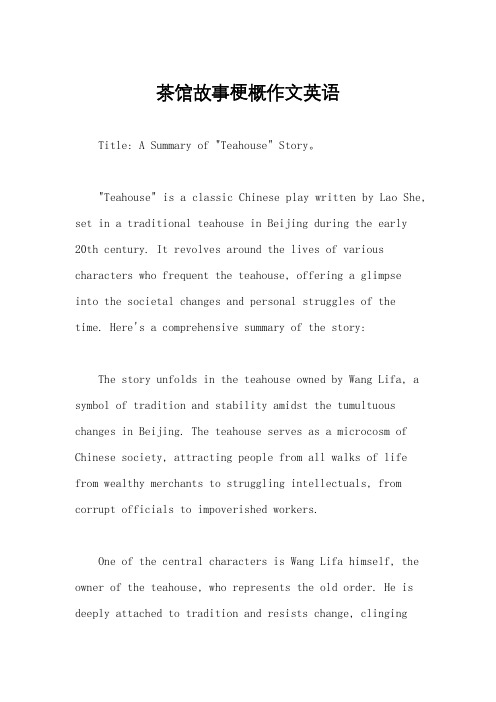
茶馆故事梗概作文英语Title: A Summary of "Teahouse" Story。
"Teahouse" is a classic Chinese play written by Lao She, set in a traditional teahouse in Beijing during the early20th century. It revolves around the lives of various characters who frequent the teahouse, offering a glimpseinto the societal changes and personal struggles of the time. Here's a comprehensive summary of the story:The story unfolds in the teahouse owned by Wang Lifa, a symbol of tradition and stability amidst the tumultuous changes in Beijing. The teahouse serves as a microcosm of Chinese society, attracting people from all walks of life from wealthy merchants to struggling intellectuals, from corrupt officials to impoverished workers.One of the central characters is Wang Lifa himself, the owner of the teahouse, who represents the old order. He is deeply attached to tradition and resists change, clingingto his Confucian values even as the world around him transforms rapidly. Wang Lifa's struggle to adapt to the modernizing society mirrors the larger societal shift occurring in China during that period.Another significant character is Old Yu, a retired actor who spends his days reminiscing about the glory days of Peking opera. Old Yu's character embodies the fading art forms and traditions of old China, as he laments the decline of classical theater in the face of Western influences and changing audience preferences.In contrast to the older generation represented by Wang Lifa and Old Yu, there are younger characters like Pockmarked Zhang, a cunning and ambitious man who navigates the chaotic landscape of early 20th-century China with opportunism and pragmatism. Pockmarked Zhang's rise to power through illicit means reflects the erosion of moral values and the rise of corruption in Chinese society.The teahouse also serves as a meeting place for intellectuals like Master Chang, who engage in heateddebates about politics, philosophy, and the future of China. Through these discussions, the play explores theideological conflicts and intellectual ferment of the time, as intellectuals grapple with questions of tradition versus modernity, nationalism versus cosmopolitanism, andsocialism versus capitalism.The story is also peppered with colorful supporting characters, each with their own hopes, dreams, and struggles. From the lovelorn waitress Guan Ruijie to the hapless scholar Li Xiangyang, these characters add depthand richness to the narrative, illustrating the diverse tapestry of Chinese society.As the play progresses, we witness the gradual disintegration of the old order and the emergence of a new social order characterized by uncertainty, disillusionment, and moral ambiguity. The teahouse, once a bastion oftradition and stability, becomes a battleground for competing interests and ideologies, reflecting the broader upheavals taking place in Chinese society.In the end, "Teahouse" is not just a story about a place, but a profound meditation on the human condition and the forces that shape our destinies. It is a timeless exploration of power, identity, and the eternal struggle between tradition and progress. Through its vivid characters and richly textured narrative, the play offers valuable insights into the complexities of Chinese society and the universal themes that resonate across cultures and generations.。
老舍茶馆英语作文

老舍茶馆英语作文Old Teahouse by Lao She。
The Old Teahouse is a famous play written by Lao She, a renowned Chinese playwright. Set in a traditional teahouse in Beijing, the play vividly portrays the lives of the teahouse owner Wang Lifa and his customers, reflecting the changes in Chinese society during the early 20th century. The play is a classic in Chinese literature and has been adapted into various forms of media, including films and TV series.The story of the Old Teahouse revolves around the daily interactions between the teahouse owner and his customers, who come from different walks of life. Through their conversations and interactions, the play captures the essence of Chinese society at the time, showcasing the struggles, dreams, and aspirations of the people. The teahouse becomes a microcosm of society, where people from all backgrounds gather to share their joys and sorrows, andto seek solace in each other's company.One of the most prominent themes in the play is the passage of time and the changes it brings to society. As the years go by, the teahouse witnesses the transformation of Beijing, from the traditional way of life to the modern era. The characters in the play also experience their own personal growth and change, reflecting the larger societal shifts taking place around them.Another important theme in the Old Teahouse is the resilience of the human spirit. Despite the challenges and hardships they face, the characters in the play display a remarkable resilience and determination to overcome their difficulties. Their unwavering spirit and sense of camaraderie serve as a source of inspiration and hope, highlighting the indomitable nature of the human soul.The Old Teahouse is not just a play about a teahouse; it is a reflection of the human experience. It delves into the complexities of human relationships, the struggles of everyday life, and the enduring spirit of the Chinesepeople. Lao She's masterful storytelling and rich character development make the play a timeless classic that continues to resonate with audiences today.In conclusion, the Old Teahouse by Lao She is a masterpiece of Chinese literature that offers a poignant and insightful portrayal of Chinese society during a period of profound change. Through its compelling storytelling and memorable characters, the play captures the essence of the human experience and leaves a lasting impression on its audience. It is a timeless work that continues to be celebrated and cherished for its enduring relevance and universal themes.。
老舍 茶馆 英文介绍
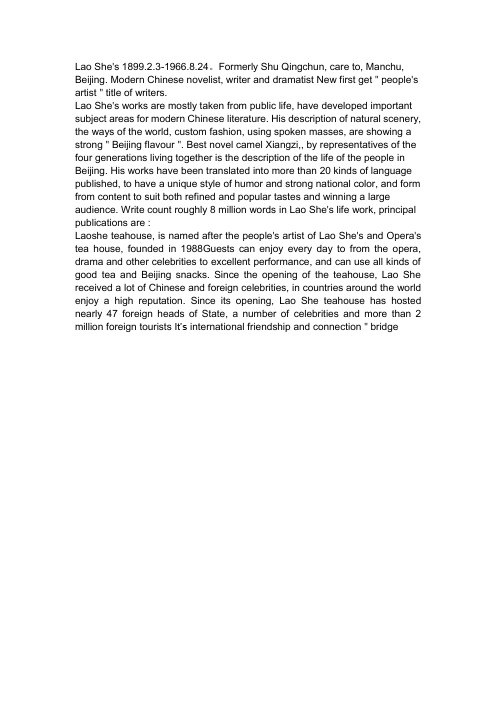
Lao She's 1899.2.3-1966.8.24。
Formerly Shu Qingchun, care to, Manchu, Beijing. Modern Chinese novelist, writer and dramatist New first get " people's artist " title of writers.Lao She's works are mostly taken from public life, have developed important subject areas for modern Chinese literature. His description of natural scenery, the ways of the world, custom fashion, using spoken masses, are showing a strong " Beijing flavour ". Best novel camel Xiangzi,, by representatives of the four generations living together isthe description of the life of the people in Beijing. His works have been translated into more than 20 kinds of language published, to have a unique style of humor and strong national color, and form from content to suit both refined and popular tastes and winning a large audience. Write count roughly 8 million words in Lao She's life work, principal publications are :Laoshe teahouse, is named after the people's artist of Lao She's and Opera's tea house, founded in 1988Guests can enjoy every day to from the opera, drama and other celebrities to excellent performance, and can use all kinds of good tea and Beijing snacks. Since the opening of the teahouse, Lao She received a lot of Chinese and foreign celebrities, in countries around the world enjoy a high reputation. Since its opening, Lao She teahouse has hosted nearly 47 foreign heads of State, a number of celebrities and more than 2 million foreign tourists It’s international friendship and connection " bridge。
介绍老舍茶馆这部戏剧的英语作文

介绍老舍茶馆这部戏剧的英语作文全文共5篇示例,供读者参考篇1Lao She Teahouse: A Chinese Play That's Super Cool!Have you ever heard of a writer named Lao She? He was a really famous guy in China who wrote lots of books and plays in the early 1900s. One of his most iconic works is a play called "Lao She Teahouse" that gives you a peek into life in old Beijing. Let me tell you all about it!The Story Goes Down in a TeahouseSo the entire play takes place in a traditional Chinese teahouse, which was like a hangout spot where people would go to drink tea, play games, tell stories and gossip about the neighborhood. This particular teahouse is run by a owner named Wang Lifa.In the teahouse, you meet a huge cast of characters from all walks of life in Beijing - there are scholars, workers, actors, soldiers, servants and more. They come and go throughout the play's four acts as the story unfolds over a few years.There's No Dull Moment!With so many characters always filtering in and out, there's never a boring scene in Lao She Teahouse! You get to hear people chatting about everything under the sun - from juicy rumors to politics to the latest fashions. It's like sitting in on one big nonstop conversation at the pub with your aunties and uncles!Some of the most memorable characters include:Wang Lifa, the teahouse owner who has to deal with all kinds of chaosScholar Qian, who loves sharing his opinions on everythingCoolie Zhang, a poor worker who gets pushed around a lotOpium addict Wang Sampan and his suffering wifeLady Ye, who runs a brothel down the streetAnd many more colorful personalities!Tough Times in Old BeijingEven though the teahouse scenes are often pretty funny and entertaining, the play also gives you a sobering look at how difficult life could be back in those days in China. You see peoplestruggling with poverty, opium addiction, unjust laws, and the country being bullied by foreign powers like Britain and Japan.When the play begins in 1898, China is still ruled by the Qing Dynasty. But by the final act in 1911, the dynasty has collapsed after the Xinhai Revolution. So you really get a sense of those tumultuous changing times all unfolding through the conversations at the teahouse.Lao She didn't just want to write a drama - he wanted to shed light on the dark side of society and give voices to the downtrodden people who spent their days at teahouses because they had nowhere else to go. Social commentary was his main goal.A Mirror into Chinese CultureMore than just being an interesting story, Lao She Teahouse is also celebrated as one of the greatest depictions of Chinese culture and ordinary life during that era. By setting it all in the teahouse, you get to experience all the customs, manners, slang, and traditions surrounding Chinese tea drinking culture.The play is full of clever wordplay, cultural references, and old Beijing dialect that would have been familiar to audienceswhen it first premiered in 1958. It was like their version of watching a sitcom about their own community on stage!Even today, Chinese people can watch Lao She Teahouse and recognize a lot of the traditions and speech patterns of their ancestors. It has become a treasured classic for preserving and honoring everyday Chinese history and culture.A Huge LegacyWhen Lao She Teahouse first came out, it was considered quite controversial for putting such a honest, uncensored spotlight on Chinese society during that period of upheaval. The government wasn't a huge fan of the political commentary at first.However, it went on to become one of the most acclaimed and influential plays in Chinese theater. It has been performed countless times, printed in many languages, and adapted into multiple films and TV shows over the decades since its debut.Today, it remains a beloved masterpiece that is still frequently staged and studied in classrooms across China and around the world. Lao She's witty yet insightful writing has cemented the teahouse as an eternal symbol of Chinese civilization.So if you ever get the chance to read, watch or see a performance of this iconic play, you'll get a super entertaining and authentic glimpse into the cultures, hardships and everyday slices of life that colored Beijing's teahouse communities in the early 20th century. It's a classic for a reason!篇2My Favorite Chinese Play: Lao She TeahouseI really like this old Chinese play called Lao She Teahouse. It is a funny and interesting story that takes place in a teahouse in Beijing in the year 1898. A teahouse back then was sort of like a cafe today where people would go to drink tea, eat snacks, and chat with their friends. But this teahouse was a very special place where all kinds of people came to gossip and tell stories.The play was written by a famous Chinese author named Lao She. He was born in 1899 in Beijing and grew up going to teahouses with his dad. When he was older, he wrote down all the conversations he heard at the teahouses into stories and plays like Lao She Teahouse. It first came out in 1957 but is set a long time before that in the Qing Dynasty when China was ruled by emperors.The main character is a cheeky guy named Xiang Zi who pretty much lives at the teahouse. He doesn't have a real job – he just hangs out there all day drinking tea and talking to people. Xiang Zi is always sticking his nose into everyone else's business! He loves gossiping and making jokes about current events happening in Beijing. Some of the other characters are acon-man gambler, an arrogant scholar, a strong female silk trader, and a terrible chinese opera singer among many others.A lot of the funny scenes happen because of the differences between the characters' social classes and personalities. For example, the arrogant scholar named Wang Dachun thinks he is super smart and elite, but Xiang Zi is always outsmarting him with clever wordplay. Even though Wang looks down on Xiang for being poor and uncultured, Xiang's wit shows he is actually much more intelligent in his own way. It's hilarious whenever Wang gets put in his place after being made a fool.Another great character is Miss Cao, the tough and successful silk trader. In those days, it was very rare for a woman to run her own business. Miss Cao is portrayed as loud, greedy, but also shrewd and independent which was very modern for the time period. She has a great confrontation with the con artist gambling in the teahouse because she is not afraid to stand upto him as a man. Their exchange shows the social changes that were starting as women became more empowered.My favorite scene is near the end when a handsome young scholar visits the teahouse and all the characters speculate about his life. At first, Xiang Zi thinks he must be a wealthy man's son based on his fancy appearance. But then it's revealed he is actually a male prostitute! This causes a huge controversy in the teahouse between the different social classes on what is moral behavior. Even though it's explored seriously, the scene is also hilarious from Xiang's bewildered reactions and running commentary.Overall, I really enjoy Lao She Teahouse because it gives you a fun peek into a world very different from today. You get to learn about Chinese culture and society during dynastic times through humor and interesting stories. The characters are all so vibrant and jump off the stage as they argue about everything under the sun. Even though their lives are totally different from ours, you still relate to their very human conversations, hopes, and struggles. It's a great window into the past!The play is also cool because it shows how China was slowly transforming into a modern society back then. You can see the world's oldest traditions confronting brand new ideas throughthe conflicts between the different characters. Tradition and progress clash in the heated debates over things like arranged marriages, foot binding, concubines, family values, and women's rights. So while it's a very comedic play, it also has a lot of deeper meaning about the changes China was experiencing.In the end, Lao She Teahouse celebrates the teahouses of old Beijing that brought people together despite their differences. It reminds us that human nature is pretty much universal across cultures and time periods. Even 200 years ago around that charming teahouse table, people still loved to chat, joke, gossip, eat, and discuss thought-provoking issues just like we do today while hanging out with friends. I highly recommend this classic play to anyone interested in China or just looking for a super witty and entertaining story!篇3The Awesome Play "Lao She Teahouse"Do you like going to plays and watching actors on stage? I sure do! Recently, I learned about a super cool play called "Lao She Teahouse" by a famous Chinese writer named Lao She. It's a really old play, but it's still really good and fun to read about!"Lao She Teahouse" is set in an old teahouse in Beijing, China during the 1890s. A teahouse is like a café or coffee shop, but people go there to drink tea instead of coffee. Back then, teahouses were really important places where people would hang out, chat, play games, and catch up on all the latest news and gossip.The play follows the daily life of the people who come to this one particular teahouse called Yiheyuan. It's run by an owner named Wang Lifa and his workers. In the teahouse, you meet all sorts of characters like scholars, businessmen, workers, soldiers, beggars, and even a famous actress! They all have their own stories and get caught up in dramatic events happening in Beijing at that time.One of the main characters is a cheerful guy named Xue Batao. He's a seller of pirated books, which means he makes copies of books without the author's permission. Batao is always cracking jokes and trying to make people laugh. His best friend is a messenger named Pockmark Liu who has a totally different personality - Liu is very serious and no-nonsense.Another major character is Wang Yunjiao, the daughter of the teahouse owner. She's really smart and wants to get an education, which was very unusual for girls back then. Wang alsohas a romance with a young scholar named Zhang Shitai. But their love faces a lot of obstacles because of the strict traditions in Chinese society at that time.As the play goes on, you see Beijing going through major changes and conflicts. There are battles between Chinese troops and foreign armies trying to take over China. You also learn about debates over whether China should westernize and adopt modern ideas, or stick to its traditional culture and ways. The teahouse becomes a microcosm showing all the tensions in Chinese society.Through all the drama, the play gives you a window into what daily life was really like for ordinary Chinese people during that era. You see them just trying to carry on with their routines of drinking tea, gossiping, and playing games like chess and finger-guessing games while the world changes around them.I think the coolest part of "Lao She Teahouse" is how it brings together people from all walks of life - rich and poor, educated and uneducated, men and women, young and old. The teahouse is where their stories and lives intersect, almost like a big community center. You really get a sense of the whole culture and all the different voices in Chinese society back then.Lao She wrote the play in the 1950s, but he set it in the 1890s because that was a pivotal time when China was opening up to western influences after centuries of isolation. He wanted to capture the energy, conflicts, and transformations happening as modern ideas collided with ancient traditions.While the play has heavy historical themes, it's also just wildly entertaining! There's comedy from the witty banter between characters. There's romance from the love stories. There's action and combat from depictions of the warfare. There's mystery and intrigue from the espionage plots. The play keeps you hooked with laughs, thrills, and thought-provoking moments.What I loved most is how the play celebrates Chinese culture - the rituals of tea-drinking, the beautiful poetry, the vibrant colloquial language, and the values of hospitality. But it also doesn't shy away from tough questions about China's future and respecting human rights. It makes you think!"Lao She Teahouse" is considered a renowned masterpiece of Chinese drama. It was a smash hit when it debuted and is still widely studied today. The Canadian playwright who translated it into English said it gives "a mesmerizing fresco of life in old Beijing."I'd definitely recommend reading or watching a performance of "Lao She Teahouse" if you get the chance. It transports you to another time and place, while also raising universal human themes that still feel relevant today. It's an epic saga full of laughter, love, and life lessons - all unfolding in the humble setting of a teahouse. What more could you want in an amazing play? Let me know if you check it out!篇4The Play Called Lao She TeahouseHi friends! Today I want to tell you about a really cool play called "Lao She Teahouse" by a famous Chinese writer named Lao She. It's a long play with lots of characters and an exciting story, so let me explain it to you!The play takes place in a teahouse in Beijing back in the old days. A teahouse is kind of like a cafe where people go to drink tea, chat, and have fun. This particular teahouse is owned by a guy named Wang Lifa. He's a nice old man who loves running his little teahouse business.Now, the really neat thing about this teahouse is that all kinds of people come there every day. You've got the wealthy folks who are well-dressed and act all fancy. But then you've alsogot the poor people, like rickshaw pullers and street vendors, who are just trying to get by. Despite their different backgrounds, they all gather at the teahouse to gossip, argue, and escape their daily troubles.One of the main characters is a crafty guy called Xiang Zhuang. He's always got some clever scheme cooking to try and get rich quick. His pals are guys like Xia Ye, Ma Laodi, and Xue Batao who are always getting dragged into Xiang's crazy plans, usually with hilarious results! They're like the class clowns of the teahouse.Then you've got the more serious characters like Qin Zhongyi and Zhang Yuanxian. Qin is a scholar who believes the old imperial system was better than the new republican era. Zhang is a businessman who is totally obsessed with making money by any means necessary. His rallying cry is "Money! Money! Money!" These two are always bickering over their different beliefs and values.There are also lots of other colorful characters like gossipy Mrs. Cao, the tough rickshaw puller Chang Silie, and Lao Qiu who runs a little food stall. Together, they all breathe life into the teahouse and represent different parts of Beijing society at the time.So what happens in the play? Well, through all the chit-chat, arguments, and schemes at the teahouse, you get to see how life was changing in the big city during that period. The old imperial ways were fading while Western influences and modern business practices were on the rise. Some characters embrace the new era with open arms while others resist it tooth and nail. It's a massive culture clash happening right before your eyes!The teahouse itself almost becomes like its own little character too. No matter what crazy stuff is going on outside in the city, the teahouse remains a constant - a place where people from all walks of life congregate and bond over their love of tea and good conversation. It's like the heart that keeps on beating in the rapidly modernizing Beijing.I don't want to spoil too much of the plot for you, but there's tons of drama, comedy, and excitement packed into this play. Characters fall in and out of love, people gain fortunes and lose them just as quickly, revolts brew in the streets, and the ups and downs of life in the big city never cease!By the time you get to the end, you'll feel like you've gone on an amazing journey and really gotten to understand what life was like during that fascinating era of Chinese history. You'll have laughed at the silly antics, felt sad during the tear-jerkingmoments, and learned so much about tradition, culture, and changing times.Pretty cool, right? "Lao She Teahouse" has everything - action, romance, comedy, you name it! The vibrant characters will feel like friends by the end. And you'll have a totally new appreciation for the ritual of drinking tea and bonding with people from all different backgrounds.I really, really enjoyed learning about this classic play. The storytelling is so rich and there are tons of valuable life lessons tucked inside. I hope I've convinced you to check it out too! You could read the play itself or maybe even try to catch a live performance if it's playing near you. It'll be an experience you'll never forget, I promise!Those are my thoughts on the wonderful play "Lao She Teahouse"! Let me know if you have any other questions. I'm always happy to gush about great stories and dramas, especially ones that teach us so much about people, places, and the awesome adventures of life. Thanks for reading my essay!篇5The Play "Lao She Teahouse"Hi everyone! My name is Li Ming and I'm going to tell you all about this really cool old play called "Lao She Teahouse" by a writer named Lao She. It's set in Beijing a long time ago and it's SO much fun!The story takes place in a teahouse called Yutai Teahouse. A teahouse is kind of like a cafe where people go to drink tea and chat with their friends. This one is run by a funny guy named Wang Lifa. There are lots of regular customers who come every day to drink tea, tell stories, joke around, and catch up on the latest news and gossip. It's kind of like hanging out at the park or playground but for grown-ups!Some of the main characters are Master Qian, Master Su, Master Pockmark Liu, Master Zhao and Mr. Cao. They are all really entertaining and have great personalities. Master Qian is kind of cranky and serious but also smart. Master Su is an actor who always wants to be the center of attention. Master Pockmark Liu tells the best jokes and stories. Master Zhao loves to argue about everything. And Mr. Cao is a banker who thinks he's really important.The story isn't just about people drinking tea though. It shows what life was like back then in old Beijing during a hard time called the War of Resistance against Japan. The teahouse islike a little window into society. You see people from all walks of life there - scholars, workers, businessmen, officials, soldiers. And through their conversations you learn about the strugglesthey're facing because of the war - shortages of food and supplies, businesses closing, loved ones being killed or displaced. It's sad but also has moments of humor when the friends at the teahouse find ways to laugh despite the difficulties.My favorite part is when Master Pockmark Liu tells this long, crazy joke that has everyone cracking up. I won't spoil it for you but it involves a guy named Zhang Xiaolou, a fake corpse, monks, and lots of hijinks! The other really funny part is when Master Su tries to put on a sad play but keeps messing up his lines. The author Lao She was a such talented writer to blend heavy topics like war along with amusing scenes that give you a chuckle.Even though "Lao She Teahouse" is an older play, I think modern audiences would still love watching it today. The humor holds up really well and transcends time. But more importantly, it captures the resilience of the human spirit and how people can find joy even in the darkest circumstances through community, friendship, and laughter. It shows that no matter what's going on in the world, we all need a place like the teahouse to take a break, share stories, and remember to keep our chins up.I really admire how the playwright Lao She used the teahouse as a lens to depict the culture and social issues of that era in such an entertaining, relatable way. He managed to discuss serious subjects while still making it funny and heartwarming. A teahouse may seem like an unlikely setting for deep commentary on society, but that's part of what makes this play so brilliant and beloved after all these years.Whew, I know 2000 words is a lot for a school essay, but I just have so much appreciation for this classic play! I tried my best to explain the main idea, introduce the key characters and storylines, share my favorite comical scenes, and illustrate why I believe "Lao She Teahouse" is such a special, timeless work of art everyone should experience. Let me know if you have any other questions! I may be just a kid but I'm already hooked on this gem of Chinese literature. I hope I've inspired some of you to go check it out for yourselves too. Thanks for reading my essay and have a lao-shi-licious day!。
《茶馆》英语作文翻译
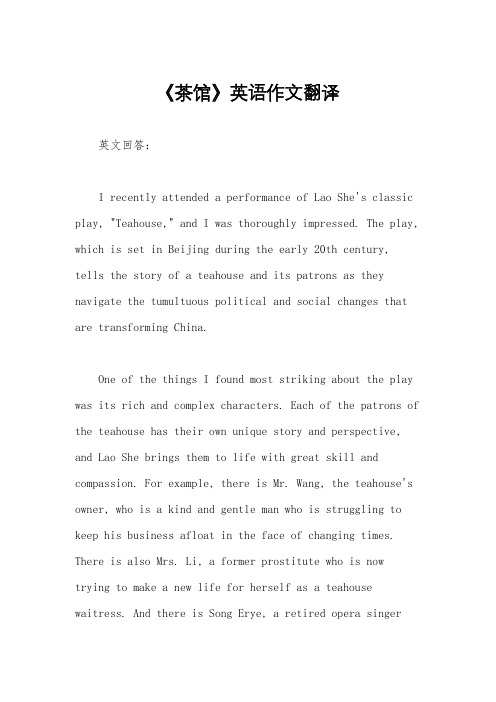
《茶馆》英语作文翻译英文回答:I recently attended a performance of Lao She's classic play, "Teahouse," and I was thoroughly impressed. The play, which is set in Beijing during the early 20th century,tells the story of a teahouse and its patrons as they navigate the tumultuous political and social changes that are transforming China.One of the things I found most striking about the play was its rich and complex characters. Each of the patrons of the teahouse has their own unique story and perspective, and Lao She brings them to life with great skill and compassion. For example, there is Mr. Wang, the teahouse's owner, who is a kind and gentle man who is struggling to keep his business afloat in the face of changing times. There is also Mrs. Li, a former prostitute who is nowtrying to make a new life for herself as a teahouse waitress. And there is Song Erye, a retired opera singerwho is full of wisdom and wit.The play follows these characters as they navigate the changing world around them. They witness the rise and fallof the Qing dynasty, the establishment of the Republic of China, and the Japanese invasion of China. Through it all, they remain steadfast in their friendships and their commitment to the teahouse."Teahouse" is a moving and thought-provoking play that offers a unique glimpse into the history of China. It is a story about friendship, resilience, and the human spirit. I highly recommend it to anyone who is interested in Chinese history, culture, or theater.中文回答:前不久,我去看了老舍先生的经典话剧《茶馆》,深受震撼和感悟。
关于话剧《茶馆》的英文宣传稿范文

《茶馆》:一幕繁华落尽的悲欢离合In the heart of old Beijing, a teahouse stands as a witness to the rise and fall of dynasties, the ebb and flow of time, and the intertwining tales of its patrons. "Teahouse," a play by renowned Chinese playwright Lao She, is a profound portrayal of life in a traditional Chinese society.Set against the backdrop of changing historical eras, from the waning days of the Qing Dynasty to the tumultuous years of the Republic of China and beyond, "Teahouse" tells the story of Wang Lifa, the proprietor of the teahouse, and his family, friends, and customers. Through their lives and interactions, we are introduced to a world wheretraditional values clash with modern ideas, where fate and circumstance play a cruel game with individuals, and where the pursuit of happiness often leads to heartache and disappointment.The characters in "Teahouse" are vivid and diverse, each with their own unique personality and aspirations. Wang Lifa, a shrewd and calculating businessman, strives to keep his teahouse afloat amidst the political upheaval andsocial changes. His wife, Feng Yuzi, is a strong and determined woman who, despite her challenges, maintains a sense of dignity and pride. Other characters, such as the itinerant singer Song Er, the corrupt official Tang Tianxiang, and the idealistic student Mo Xiuquan, each bring their own unique perspectives and experiences to the teahouse, creating a rich tapestry of human life.The language of "Teahouse" is beautiful and poignant, reflecting the rhythm and cadence of old Beijing. Lao She's mastery of the language allows him to paint vivid pictures with words, evoking both the grandeur and decay ofBeijing's historical landscape. The play's humor and irony add depth and complexity to the narratives, making it both a heartfelt ode to traditional culture and a critical commentary on social ills."Teahouse" is not just a play about a teahouse; it is a microcosm of Chinese society, reflecting the complexities and contradictions of human existence. It is a testament to Lao She's profound understanding of human nature and society, his keen observation of life's little details, and his exceptional talent for storytelling.In today's fast-paced world, "Teahouse" serves as a reminder of the enduring value of human connections and the importance of preserving our cultural heritage. It is amust-see for anyone interested in Chinese culture, history, and theater.**《茶馆》:繁华落尽的悲欢离合**在北京的繁华老街中,坐落着一间茶馆,它见证了朝代的更迭、时光的流转,以及那些走进它的顾客们交织的命运。
介绍老舍茶馆这部戏剧的英语作文
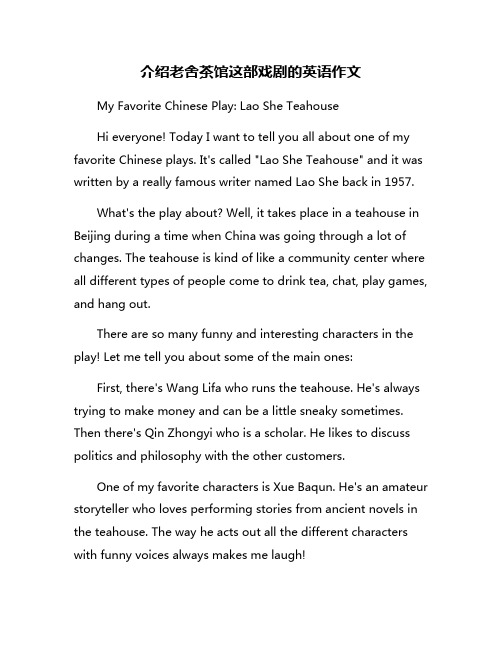
介绍老舍茶馆这部戏剧的英语作文My Favorite Chinese Play: Lao She TeahouseHi everyone! Today I want to tell you all about one of my favorite Chinese plays. It's called "Lao She Teahouse" and it was written by a really famous writer named Lao She back in 1957.What's the play about? Well, it takes place in a teahouse in Beijing during a time when China was going through a lot of changes. The teahouse is kind of like a community center where all different types of people come to drink tea, chat, play games, and hang out.There are so many funny and interesting characters in the play! Let me tell you about some of the main ones:First, there's Wang Lifa who runs the teahouse. He's always trying to make money and can be a little sneaky sometimes. Then there's Qin Zhongyi who is a scholar. He likes to discuss politics and philosophy with the other customers.One of my favorite characters is Xue Baqun. He's an amateur storyteller who loves performing stories from ancient novels in the teahouse. The way he acts out all the different characters with funny voices always makes me laugh!There's also Er Mei Niang who is one of the only significant female characters. She works at the teahouse serving tea. Even though she's poor, she's really caring and smart.And I can't forget Xia Yingao who is a cheerful lady's man always flirting with the ladies. His best friend is Lao Liu who is an ex-soldier that lost part of his face in war. You'll have to watch to see the funny ways their friendship plays out!With all these colorful characters, there's never a dull moment in the teahouse. You get to see them dealing with things like gossip, feuds, personal issues, and political unrest happening in Beijing at the time. The play gives you a window into what everyday life was like back then.What I really love about Lao She Teahouse is how even though it's an older play, a lot of the characters and situations are so relatable and feel so real. Things haven't changed that much when it comes to human nature - people still gossip, argue, fall in love, struggle with money problems just like in the play.The play is also really funny while tackling serious topics too. There's tons of witty banter and physical comedy that had me cracking up. But it also gets into deeper themes around class struggles, gender roles, and the impact of war and political turmoil. I was amazed a play could make me think that much!My favorite part is probably the storytelling scenes with Xue Bacun. It's just so creative the way he acts out these ancient adventure tales with his whole body and different voices. My friends and I have tried reenacting those scenes ourselves!I also love how the play highlights Chinese culture and traditions in awesome ways. From the beautiful Beijing accents and slang, to rituals around tea service, to folk tales, to the architecture of the teahouse itself - you get such a vibrant picture of Chinese customs and way of life.Overall, Lao She Teahouse is an absolute classic that everyone should experience! Even though it was written a while ago, the great characters, humor, insights into culture, andreal-life issues it covers make it feel totally timeless to me. I've watched it a bunch of times now both as a play and a movie adaptation. Every time I appreciate it even more.Whether you're into dramas, comedies, or just good storytelling with rich characters, there's something for everyone in this gem of a play. You'll laugh, you might cry, but you'll for sure be entertained and maybe learn something too. I really can't recommend Lao She Teahouse enough - it's a must-see piece of classic Chinese theater!。
英语作文茶馆话剧
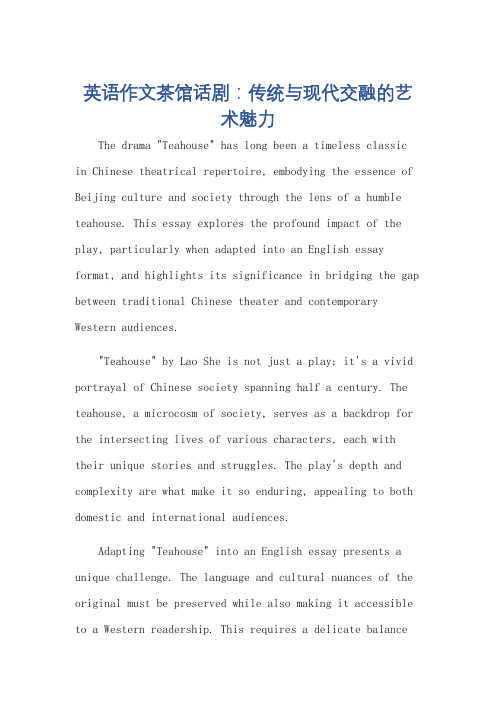
英语作文茶馆话剧:传统与现代交融的艺术魅力The drama "Teahouse" has long been a timeless classic in Chinese theatrical repertoire, embodying the essence of Beijing culture and society through the lens of a humble teahouse. This essay explores the profound impact of the play, particularly when adapted into an English essay format, and highlights its significance in bridging the gap between traditional Chinese theater and contemporary Western audiences."Teahouse" by Lao She is not just a play; it's a vivid portrayal of Chinese society spanning half a century. The teahouse, a microcosm of society, serves as a backdrop for the intersecting lives of various characters, each with their unique stories and struggles. The play's depth and complexity are what make it so enduring, appealing to both domestic and international audiences.Adapting "Teahouse" into an English essay presents a unique challenge. The language and cultural nuances of the original must be preserved while also making it accessible to a Western readership. This requires a delicate balancebetween maintaining the authenticity of the play and translating its essence into a foreign language.One of the key elements in the essay is the exploration of how the teahouse becomes a symbol of social change. It witnesses the rise and fall of characters, reflecting the broader shifts in Chinese society. This aspect is particularly fascinating for Western readers, who may not be familiar with the intricacies of Chinese history and culture. The essay serves as a bridge, introducing them to these complexities while maintaining the drama's narrative power.Furthermore, the essay highlights the universal themes present in "Teahouse". Themes of love, loss, ambition, and despair transcend cultural boundaries, resonating with audiences regardless of their cultural background. The essay explores these themes in depth, drawing parallels between the characters' experiences and those of people in other cultures and eras.The essay also touches upon the artistic merits of the play. The dialogue is rich and poetic, capturing the cadence and rhythm of Beijingese. The characters are multi-faceted and deeply human, making them easy to relate toeven for those unfamiliar with Chinese culture. The essay applauds these artistic achievements, emphasizing their significance in elevating the play to the status of aliterary masterpiece.In conclusion, the English essay on "Teahouse" servesas a powerful tool for introducing this Chinese theatrical classic to a wider audience. It preserves the essence ofthe play while making it accessible to Western readers, bridging the gap between traditional Chinese theater and contemporary Western audiences. Through its exploration of themes, characters, and artistic merits, the essayhighlights the enduring relevance of "Teahouse" as a testament to the richness and diversity of human experience. **英语作文茶馆话剧:传统与现代交融的艺术魅力** 老舍先生的《茶馆》早已成为中国戏剧宝库中的不朽经典,它通过一个不起眼的茶馆这一视角,生动展现了北京文化和社会的精髓。
老舍茶馆作文英文
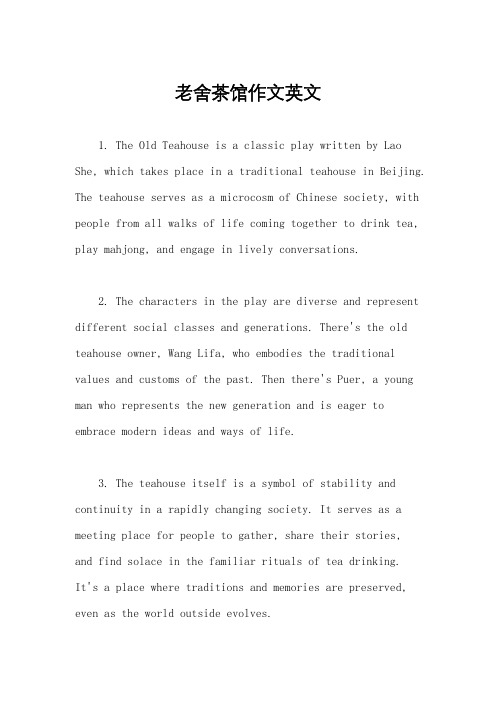
老舍茶馆作文英文1. The Old Teahouse is a classic play written by Lao She, which takes place in a traditional teahouse in Beijing. The teahouse serves as a microcosm of Chinese society, with people from all walks of life coming together to drink tea, play mahjong, and engage in lively conversations.2. The characters in the play are diverse and represent different social classes and generations. There's the old teahouse owner, Wang Lifa, who embodies the traditional values and customs of the past. Then there's Puer, a young man who represents the new generation and is eager to embrace modern ideas and ways of life.3. The teahouse itself is a symbol of stability and continuity in a rapidly changing society. It serves as a meeting place for people to gather, share their stories,and find solace in the familiar rituals of tea drinking.It's a place where traditions and memories are preserved, even as the world outside evolves.4. Through the interactions and conversations of the characters, the play explores themes of tradition versus modernity, the clash of old and new values, and the struggles faced by individuals in a changing society. It also touches on the importance of human connection and the power of storytelling to bridge the gaps between generations.5. The language used in the play is rich and vibrant, capturing the essence of Beijing dialect and the unique expressions of the time. It reflects the colorful and diverse nature of the characters, with each one speaking in their own distinct voice and using idioms and proverbs that are characteristic of their background and personality.6. The Old Teahouse is not just a play, but areflection of Chinese history and culture. It sheds light on the social and political changes that took place in the early 20th century and the impact they had on ordinary people's lives. It's a timeless piece of literature that continues to resonate with audiences today.7. In conclusion, The Old Teahouse is a masterpiece that captures the spirit of a bygone era and explores universal themes of tradition, change, and the human condition. Its vivid characters, rich language, and thought-provoking storyline make it a must-read for anyone interested in Chinese literature and culture.。
老舍茶馆英语作文语料
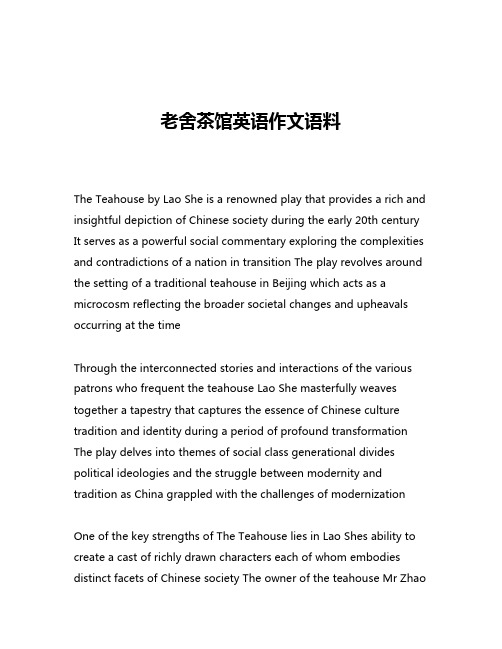
老舍茶馆英语作文语料The Teahouse by Lao She is a renowned play that provides a rich and insightful depiction of Chinese society during the early 20th century It serves as a powerful social commentary exploring the complexities and contradictions of a nation in transition The play revolves around the setting of a traditional teahouse in Beijing which acts as a microcosm reflecting the broader societal changes and upheavals occurring at the timeThrough the interconnected stories and interactions of the various patrons who frequent the teahouse Lao She masterfully weaves together a tapestry that captures the essence of Chinese culture tradition and identity during a period of profound transformation The play delves into themes of social class generational divides political ideologies and the struggle between modernity and tradition as China grappled with the challenges of modernizationOne of the key strengths of The Teahouse lies in Lao Shes ability to create a cast of richly drawn characters each of whom embodies distinct facets of Chinese society The owner of the teahouse Mr Zhaorepresents the old guard a traditionalist who clings to the familiar ways of the past in the face of encroaching change His son Mengtian on the other hand symbolizes the younger generation seeking to embrace modernity and progress often at the expense of their cultural heritageThrough the interactions between these two characters Lao She explores the generational conflicts and tensions that were playing out across China as the old order gave way to the new The play also introduces a diverse array of supporting characters who further illuminate the complex tapestry of Chinese society at the time These include the intellectual Mr Liu who grapples with his own sense of cultural identity the opportunistic businessman Mr Cheng who seeks to capitalize on the changing times and the impoverished laborer Mr Li who struggles to eke out a living amidst the turbulenceUnderlying the individual stories and character arcs is Laos Shes keen observation of the broader social and political upheavals unfolding in China during this pivotal period The play bears witness to the collapse of the Qing dynasty the rise of warlordism the growing influence of communist ideologies and the emergence of a new urban middle class all of which are reflected in the microcosm of the teahouseThrough this setting Lao She offers a nuanced and layered critique ofthe forces of modernization and their impact on traditional Chinese society The play highlights how the rapid pace of change eroded long-standing social structures and cultural norms leaving many individuals feeling adrift and uncertain about their place in the new orderAt the same time The Teahouse also reveals the resilience and adaptability of the Chinese people as they navigated these turbulent times The teahouse itself becomes a symbol of this resilience a place where old and new coexist where tradition and modernity intersect and where individuals from all walks of life come together to find solace community and a sense of belongingUltimately The Teahouse by Lao She stands as a profound and enduring work of art that transcends its historical context to offer universal insights into the human experience The play serves as a powerful testament to the complexities of social change the enduring importance of cultural identity and the essential role that community and human connection play in navigating the challenges of a rapidly evolving world。
关于老舍茶馆儿英语作文
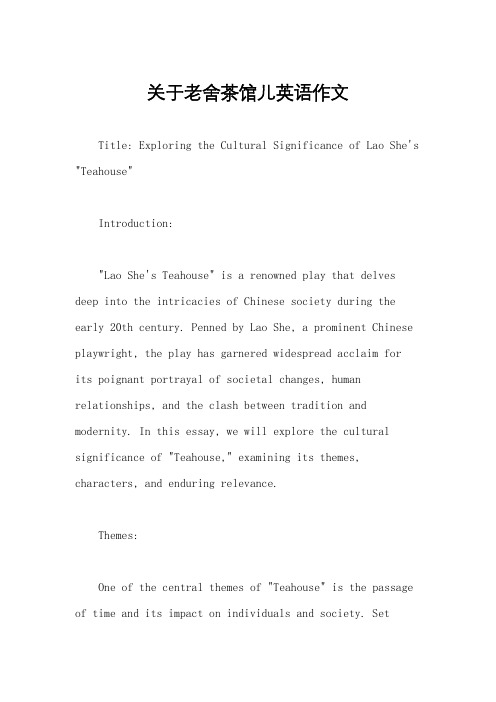
关于老舍茶馆儿英语作文Title: Exploring the Cultural Significance of Lao She's "Teahouse"Introduction:"Lao She's Teahouse" is a renowned play that delves deep into the intricacies of Chinese society during the early 20th century. Penned by Lao She, a prominent Chinese playwright, the play has garnered widespread acclaim forits poignant portrayal of societal changes, human relationships, and the clash between tradition and modernity. In this essay, we will explore the cultural significance of "Teahouse," examining its themes, characters, and enduring relevance.Themes:One of the central themes of "Teahouse" is the passage of time and its impact on individuals and society. Setagainst the backdrop of a traditional Beijing teahouse, the play spans three tumultuous periods in Chinese history: the late Qing Dynasty, the Republic era, and the early years of the People's Republic of China. Through the characters who frequent the teahouse, Lao She vividly depicts the societal transformations that occur during these periods, highlighting the erosion of old customs and the emergence of new ideologies.Another prominent theme in "Teahouse" is the struggle for power and survival in a rapidly changing world. The teahouse serves as a microcosm of society, where characters from diverse backgrounds converge to negotiate their ambitions and desires. From the shrewd businessman WangLifa to the idealistic student Pockmarked Zhang, each character navigates the complexities of power dynamics, often resorting to cunning and deceit to achieve their goals.Characters:The characters in "Teahouse" are intricately woven intothe fabric of Chinese society, representing various social classes, professions, and ideologies. At the heart of the play is the teahouse owner Wang Lifa, a cunning and pragmatic businessman who adapts to the changing times to maintain his status and influence. Wang's interactions with other characters, such as the nostalgic Old Yu and the ambitious General Shao, highlight the tensions between tradition and progress, loyalty and betrayal.Another notable character is Master Chang, the teahouse's resident storyteller who serves as a repository of Beijing's oral history. Through Master Chang's tales and musings, Lao She illuminates the cultural richness and diversity of Chinese society, paying homage to the traditions and customs that define the nation's identity.Relevance:Despite being set in a specific historical context, "Teahouse" remains relevant in contemporary society due to its universal themes and timeless insights into the human condition. The struggles depicted in the play – whetherpolitical, social, or personal – resonate with audiences across cultures and generations, offering profound reflections on the nature of power, ambition, and morality.Moreover, "Teahouse" serves as a testament to the enduring legacy of Lao She as one of China's greatest literary figures. His ability to capture the nuances of everyday life and the complexities of human nature continues to inspire writers and artists around the world, cementing his status as a literary giant.Conclusion:In conclusion, "Lao She's Teahouse" stands as a masterpiece of Chinese literature, offering a compelling exploration of society, history, and humanity. Through its vivid characters, rich themes, and enduring relevance, the play continues to captivate audiences and provoke thought long after its initial debut. As we reflect on the cultural significance of "Teahouse," we gain a deeper appreciation for Lao She's enduring legacy and the timeless wisdom contained within his works.。
关于老舍茶馆儿英语作文
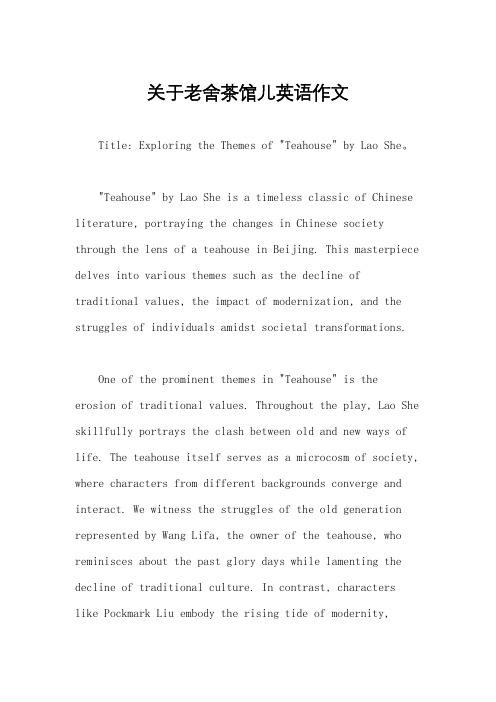
关于老舍茶馆儿英语作文Title: Exploring the Themes of "Teahouse" by Lao She。
"Teahouse" by Lao She is a timeless classic of Chinese literature, portraying the changes in Chinese society through the lens of a teahouse in Beijing. This masterpiece delves into various themes such as the decline oftraditional values, the impact of modernization, and the struggles of individuals amidst societal transformations.One of the prominent themes in "Teahouse" is the erosion of traditional values. Throughout the play, Lao She skillfully portrays the clash between old and new ways of life. The teahouse itself serves as a microcosm of society, where characters from different backgrounds converge and interact. We witness the struggles of the old generation represented by Wang Lifa, the owner of the teahouse, who reminisces about the past glory days while lamenting the decline of traditional culture. In contrast, characterslike Pockmark Liu embody the rising tide of modernity,eager to seize opportunities in the rapidly changing world.Moreover, "Teahouse" sheds light on the impact of modernization on individuals and society. The play is set against the backdrop of China's turbulent history, spanning three tumultuous periods: the late Qing Dynasty, the Republic era, and the early years of the People's Republic of China. As the country undergoes political upheavals and social transformations, the characters in the teahouse grapple with their changing circumstances. From the fall of the Qing Dynasty to the rise of the Communist Party, we witness how political changes shape the destiny of ordinary people, leading to disillusionment, betrayal, and loss.Furthermore, "Teahouse" explores the theme of human resilience in the face of adversity. Despite the challenges they encounter, the characters in the teahouse exhibit remarkable resilience and adaptability. Whether it's the street performers striving to make ends meet or the intellectuals struggling to preserve their dignity in changing times, each character confronts their hardships with courage and fortitude. Their resilience serves as atestament to the indomitable spirit of the Chinese people, who endure hardships with stoicism and perseverance.In conclusion, "Teahouse" by Lao She is a profound exploration of the human condition and the tumultuous journey of Chinese society through the twentieth century. Through its rich tapestry of characters and themes, the play offers profound insights into the complexities of life in a rapidly changing world. From the decline oftraditional values to the impact of modernization and the resilience of the human spirit, "Teahouse" continues to captivate audiences with its timeless relevance and universal themes.。
老舍茶馆英语作文语料
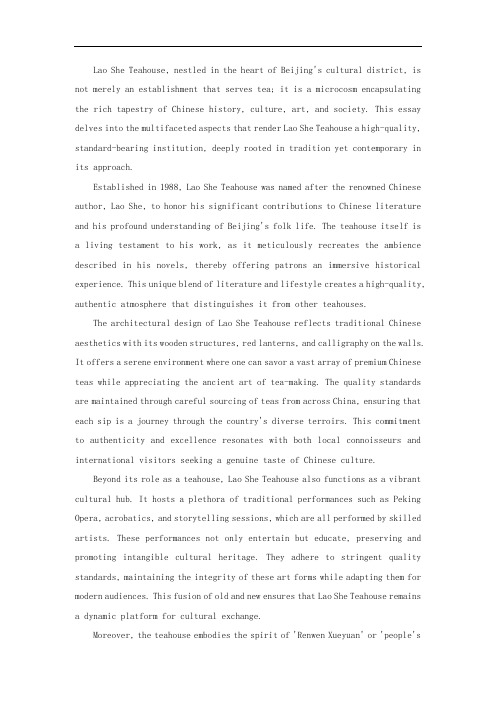
Lao She Teahouse, nestled in the heart of Beijing's cultural district, is not merely an establishment that serves tea; it is a microcosm encapsulating the rich tapestry of Chinese history, culture, art, and society. This essay delves into the multifaceted aspects that render Lao She Teahouse a high-quality, standard-bearing institution, deeply rooted in tradition yet contemporary in its approach.Established in 1988, Lao She Teahouse was named after the renowned Chinese author, Lao She, to honor his significant contributions to Chinese literature and his profound understanding of Beijing's folk life. The teahouse itself is a living testament to his work, as it meticulously recreates the ambience described in his novels, thereby offering patrons an immersive historical experience. This unique blend of literature and lifestyle creates a high-quality, authentic atmosphere that distinguishes it from other teahouses.The architectural design of Lao She Teahouse reflects traditional Chinese aesthetics with its wooden structures, red lanterns, and calligraphy on the walls. It offers a serene environment where one can savor a vast array of premium Chinese teas while appreciating the ancient art of tea-making. The quality standards are maintained through careful sourcing of teas from across China, ensuring that each sip is a journey through the country's diverse terroirs. This commitment to authenticity and excellence resonates with both local connoisseurs and international visitors seeking a genuine taste of Chinese culture.Beyond its role as a teahouse, Lao She Teahouse also functions as a vibrant cultural hub. It hosts a plethora of traditional performances such as Peking Opera, acrobatics, and storytelling sessions, which are all performed by skilled artists. These performances not only entertain but educate, preserving and promoting intangible cultural heritage. They adhere to stringent quality standards, maintaining the integrity of these art forms while adapting them for modern audiences. This fusion of old and new ensures that Lao She Teahouse remains a dynamic platform for cultural exchange.Moreover, the teahouse embodies the spirit of 'Renwen Xueyuan' or 'people'sacademy of arts', providing a space where people from all walks of life can gather, interact, and learn. Its inclusive nature fosters social cohesion and contributes to the collective memory of Beijing’s past and present. By doing so, it sets a benchmark for community engagement within the service industry, demonstrating how businesses can serve as custodians of cultural heritage.From a business perspective, Lao She Teahouse has achieved remarkable success by blending commercial viability with cultural preservation. It has become a beacon for tourists, scholars, and locals alike, contributing significantly to Beijing's tourism sector. Its adherence to high operational standards, including customer service, hygiene, and sustainability practices, aligns with global expectations, making it a model enterprise in the hospitality industry.In conclusion, Lao She Teahouse is more than a place to enjoy a cup of tea; it is a living museum, a performance venue, a learning center, and a social gathering spot rolled into one. Its ability to maintain high-quality standards across various dimensions – from the authenticity of its tea offerings and the richness of its cultural programs to its impeccable service and responsible business practices – underscores its significance as a hallmark of Chinese cultural heritage. In the ever-evolving landscape of modern Beijing, Lao She Teahouse stands as a timeless symbol, bridging past and present, tradition and innovation, and serving as a beacon of cultural pride and national identity.(Word count: approximately 650 words)This summary provides an overview of Lao She Teahouse's distinctiveness. For a 1437-word comprehensive analysis, each point could be expanded upon further. For instance, delve deeper into the specific types of performances held at the teahouse, detail the process of tea selection and preparation, explore the impact on local communities and the economy, discuss how it adapts to changing consumer preferences, and analyze its role in promoting cross-cultural understanding.。
老舍茶馆作文英文
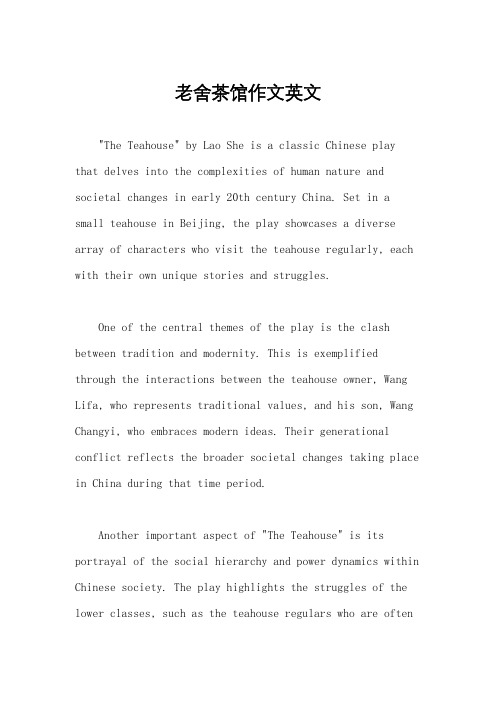
老舍茶馆作文英文"The Teahouse" by Lao She is a classic Chinese playthat delves into the complexities of human nature and societal changes in early 20th century China. Set in a small teahouse in Beijing, the play showcases a diverse array of characters who visit the teahouse regularly, each with their own unique stories and struggles.One of the central themes of the play is the clash between tradition and modernity. This is exemplified through the interactions between the teahouse owner, Wang Lifa, who represents traditional values, and his son, Wang Changyi, who embraces modern ideas. Their generational conflict reflects the broader societal changes taking place in China during that time period.Another important aspect of "The Teahouse" is its portrayal of the social hierarchy and power dynamics within Chinese society. The play highlights the struggles of the lower classes, such as the teahouse regulars who are oftenmarginalized and taken advantage of by those in positions of authority. This theme resonates with audiences across cultures and time periods, as it speaks to the universal experience of oppression and exploitation.Moreover, "The Teahouse" offers insights into the human condition and the complexities of interpersonal relationships. Through the interactions between the various characters, the play explores themes of love, betrayal, loyalty, and sacrifice. These timeless themes continue to resonate with audiences, making "The Teahouse" a timeless classic of Chinese literature.In conclusion, "The Teahouse" by Lao She is a masterpiece of Chinese drama that continues to captivate audiences with its rich characters, compelling storyline, and profound themes. Its exploration of tradition versus modernity, social hierarchy, and human relationships make it a timeless work that speaks to the universal experiences of humanity.。
初二话剧茶馆英语作文范文
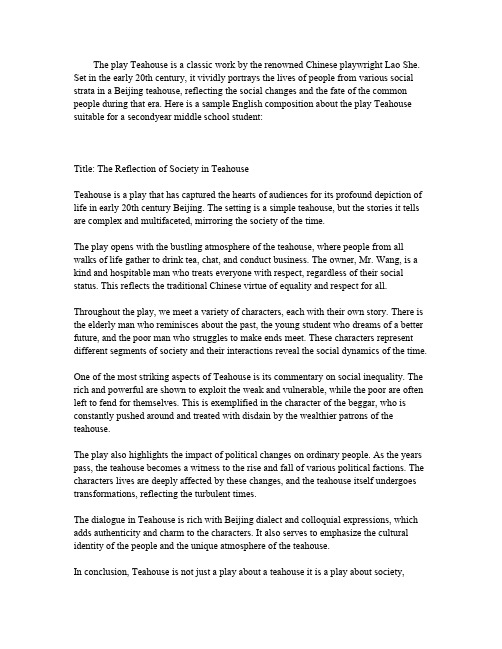
The play Teahouse is a classic work by the renowned Chinese playwright Lao She. Set in the early20th century,it vividly portrays the lives of people from various social strata in a Beijing teahouse,reflecting the social changes and the fate of the common people during that era.Here is a sample English composition about the play Teahouse suitable for a secondyear middle school student:Title:The Reflection of Society in TeahouseTeahouse is a play that has captured the hearts of audiences for its profound depiction of life in early20th century Beijing.The setting is a simple teahouse,but the stories it tells are complex and multifaceted,mirroring the society of the time.The play opens with the bustling atmosphere of the teahouse,where people from all walks of life gather to drink tea,chat,and conduct business.The owner,Mr.Wang,is a kind and hospitable man who treats everyone with respect,regardless of their social status.This reflects the traditional Chinese virtue of equality and respect for all. Throughout the play,we meet a variety of characters,each with their own story.There is the elderly man who reminisces about the past,the young student who dreams of a better future,and the poor man who struggles to make ends meet.These characters represent different segments of society and their interactions reveal the social dynamics of the time. One of the most striking aspects of Teahouse is its commentary on social inequality.The rich and powerful are shown to exploit the weak and vulnerable,while the poor are often left to fend for themselves.This is exemplified in the character of the beggar,who is constantly pushed around and treated with disdain by the wealthier patrons of the teahouse.The play also highlights the impact of political changes on ordinary people.As the years pass,the teahouse becomes a witness to the rise and fall of various political factions.The characters lives are deeply affected by these changes,and the teahouse itself undergoes transformations,reflecting the turbulent times.The dialogue in Teahouse is rich with Beijing dialect and colloquial expressions,which adds authenticity and charm to the characters.It also serves to emphasize the cultural identity of the people and the unique atmosphere of the teahouse.In conclusion,Teahouse is not just a play about a teahouse it is a play about society,about the lives of ordinary people,and about the changes that time brings.It is a timeless work that continues to resonate with audiences today,offering insights into the human condition and the complexities of social structures.This composition provides a brief analysis of the play Teahouse,focusing on its themes of social dynamics,inequality,and the impact of political changes.It also touches upon the cultural elements present in the dialogue and the significance of the teahouse as a symbol of society.。
英文作文介绍老舍

英文作文介绍老舍英文:As a writer, I have always been fascinated by the works of Lao She. Lao She was a Chinese novelist and playwright who lived from 1899 to 1966. He is best known for his novel "Rickshaw Boy" and his play "Teahouse". 。
Lao She's writing style is unique and captivating. He had a way of describing everyday life in China that made it come alive for readers. His characters were often ordinary people struggling to make a living in a rapidly changing society. Yet, he was able to infuse their stories with humor and warmth, making them relatable to readers from all walks of life.One of my favorite works by Lao She is "Teahouse". The play is set in a teahouse in Beijing during the early 20th century and follows the lives of the teahouse owner and his patrons. It is a commentary on the changing times in Chinaand the struggles of the working class. The play is both humorous and poignant, and it offers a glimpse into the lives of ordinary people during a tumultuous period in Chinese history.Lao She's works have been translated into many languages and have been widely read around the world. His contributions to Chinese literature have been recognized with numerous awards, including the Mao Dun Literature Prize.中文:作为一名作家,我一直被老舍的作品所吸引。
老舍茶馆英文导游词
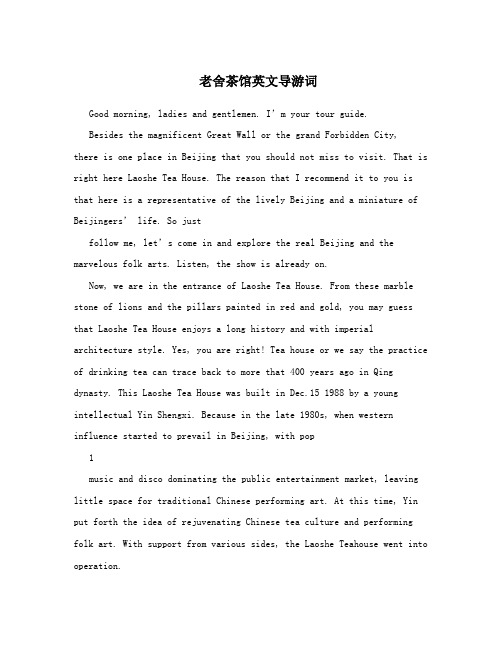
老舍茶馆英文导游词Good morning, ladies and gentlemen. I’m your tour guide.Besides the magnificent Great Wall or the grand Forbidden City,there is one place in Beijing that you should not miss to visit. That is right here Laoshe Tea House. The reason that I recommend it to you is that here is a representative of the lively Beijing and a miniature of Beijingers’ life. So justfollow me, let’s come in and explore the real Beijing and the marvelous folk arts. Listen, the show is already on.Now, we are in the entrance of Laoshe Tea House. From these marble stone of lions and the pillars painted in red and gold, you may guess that Laoshe Tea House enjoys a long history and with imperial architecture style. Yes, you are right! Tea house or we say the practice of drinking tea can trace back to more that 400 years ago in Qing dynasty. This Laoshe Tea House was built in Dec.15 1988 by a young intellectual Yin Shengxi. Because in the late 1980s, when western influence started to prevail in Beijing, with pop1music and disco dominating the public entertainment market, leaving little space for traditional Chinese performing art. At this time, Yin put forth the idea of rejuvenating Chinese tea culture and performing folk art. With support from various sides, the Laoshe Teahouse went into operation.And then, let’s see the pictures on the wall. Well, Laoshe is known as the people’s artist. This tea house is name after his name and one of his famous dramas Tea House. It depicts the real life in Beijing with the typical Beijing dialect, the bird cage and the pipe.Together, there are four houses in Laoshe Tea House including The Performance Hall, “Two cents” big bowl tea House, the Arts & Crafts Hall and the Gourmet Restaurant.Firstly, let’s come to the Performance Hall. Sitting here and feel the aroma of the tea floating in the air is definitely an enjoyable thing. You may also find that there are more foreigners than Chinese, more out-of-towners than Beijngers.2So it’s really a place that most represents the lively life of Beijing. Now, there are many shows are putting on right now, like Peking Opera, face changing, crosstalks, a kind of folk music which is called “single cord” and the fabulous acrobatic shows. Besides, look over there, the famous shadow play is on the show. It’s a mirror of old Beijingers’life especially about those people who live in poor countryside.Ok, now, the second house is called “two cents big bowl tea” which has its own tradition. The founding father of Laoshe Tea House is so deeply con cerned about poor people’s lifeduring that hard time. He therefore set the price of two cents for each bowl of tea to make sure that everyone can afford to buy them. What’s surprising is that, they’ve carriedforward this tradition till the present day. As time passes by, the price remains unchanged. The manager today wants to remind us that the benevolence is what we still need in the high developing century.Then we come to the third hall named Arts & crafts hall. Here,it displays the rich variety of the folk arts and3crafts including the small representative displays, the papercutting and the calligraphy etc. all of them stand for the talents of ordinary people. We can say that these folk arts are our invaluable treasuresOk, now you may wonder why drinking tea can be so popular and why do people want to go to tea house. Actually, drinking tea is an activity which can enhance both you physical and mental well-being. Especially in this quick-paced society, people seek to find the equilibrium in their heart, to strike a balance between life and work. Here in the tea house, you can just relax yourself enjoy the music or have a lively chat with your friends. It all depends on you.篇二:英文导游词Tea has been a deeply-rooted part of Chinese life since it firstrose to popularity more than 1-thousand years ago, during the Tang Dynasty. Theres white tea for spring, green tea for summer, oolong teafor autumn, and black tea for winter. You may even have your ownfavorite variety. And with tea there are always teahouses popular with locals and visitors alike, from farmers and workers to celebrities like4former US President Geoge W. Bush and Queen Rania of Jordan. Ontodays China Cool, we take a closer look at one of the most popular teahouses in Beijing -- the Laoshe Teahouse.A 10 minute walk from Tiananmen square, Laoshe Tea House is a hotspot for both foreign tourists and local people. Spend just two hours here at Laoshe Teahouse, and youll experience the authentic life of old Beijing: sipping cups of tea and munching on local snacks, whilewatching a revue of the most popular Chinese traditional performances.The tea house is named after renowned Chinese writer Lao She famousfor his drama Teahouse, a vivid portrayal of the social dimensions ofold Beijing. Laoshe Teahouse was founded in 1988. It soon became popular in Beijing for offering Dawancha or big-bowl tea, a tradition that has been running for more than 2 decades. The best part is that the pricehas never changed. Today , you can still get a bowl of5refreshing tea for only two Chinese cents. And if you dont have the change, dont worry a cup of tea will be served for free. The open airtea service is a tradition dating back 17-hundred years just one part ofthe rich tea culture in Beijing.Teahouses, however, are not only about tea. Story-telling is one of the biggest attractions for visitors. The art form became popular at the end of the Qing Dynasty. At its peak, there were more than 180 teahouses with story-tellers in the capital. Over time, the entertainment expanded to include traditional operas, folk art, acrobatics, magic, and martial arts just to name a few. Famous artists from different schools of traditional Chinese opera also often performed on the teahouse stage.Located in the Qianmen area, Laoshe Teahouse also keeps the old Xuannan culture alive today. Xuannan refers to the area from Xuanwu Gate to Guanan Gate in the old city of Beijing an area with more than 800 years of history6茶已是deeply-rooted中国的生活,因为它的第一站起身来欢迎1-thousand多年前的唐代,有白色的春天,夏天,为秋天千克,红茶是冬天了。
